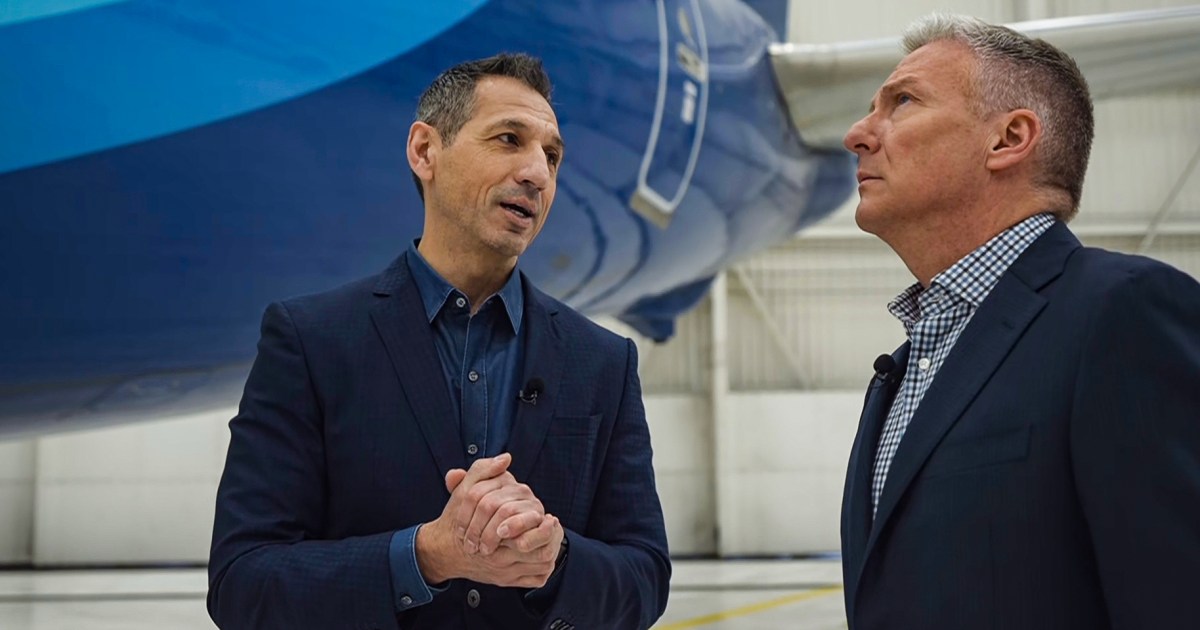Well it’s a good thing they did stock buybacks instead of investing in basic safety and inspection practices. Seems to have really worked out well in the long term.
Or instead of investing in a redundancy or software failsafe for the angle-of-attack sensor that was problematic back in 2019.
But then the managers would have got fewer bonuses. How can you be so heartless?
It’s like nobody cares about the shareholders these days.
I’m a shareholder, and it has not been great lately
Maybe we could start a Gofundme or something.
Or investing in a plane design that was not lopsided due to being rushed out the door to compete with Airbus, necessitating the need for the MCAS system to begin with because they also didn’t want to invest in pilot retraining on how to fly a lopsided plane.
Nothing can be done! If we add a backup AOA sensor the cost of the plane will increase by 0,00001% tHiNk Of ThE ShArEhOlDeRs!!1!!
Getting these planes from the factory with loose bolts is pretty inexcusable. Boeing’s really fallen far. Kind of crazy that the airline has to go double check that the brand new plane they got from the manufacturer is actually put together properly.
I have known Boeing workers, I called them friends. My friends would tell me how stressful each bolt and rivet can be. Like you have to sign off on all your work, every screw. I don’t know what that environment is like now, but in years past those workers took high pride in their work. And the executives were the ones that caused the problems with their work.
An article I read about it said that they outsourced it to another company, then that company fired all their experienced workers during covid. So the answer to it and everything is short sighted greed.
For a change
Yaya. I feel like a pretty dramatic shift in how Boeing designs, builds, and signs off on things really has to come from the top first
I’ve heard that the board of directors got rid of a lot of the old executive team, that was made up of people that had worked as engineers and knew how to build an airplane, and brought in people that instead knew how to maximize profit and reduce costs.
Tale as old as Jack Welch’s first day at GE
GE builds bombs, Boeing builds planes that could plow into the ground… either way, they’re trying to kill people.
Yes, but GE, under the leadership of Jack Welch was the pioneer of the “shareholder profits are the only thing that matters” brand of capitalism in the post WWII era. Prior to Welch GE and most American companies during that time were prioritizing what their company produced, attempted to innovate, and treated their workers with some dignity. Certainly not perfect as foreign exploitation was a major leg propping it up but a far cry from where we are today.
It’s all subcontracted out now to limit liability, and the workers are understaffed
The FAA is one of the few agencies that still has teeth. They will likely hold Boeing’s feet to the fire because the buck stops with them. I worked for a smaller aircraft manufacturer, and if we outsourced parts that failed, saying “oh it was the other company’s fault” would not be a valid excuse for the FAA. There would still be investigations into our practices, questions about why we didn’t have adequate inspections to verify the parts when they came in, and reviews into our vendor vetting processes. Any fines or disciplinary action would fall on us, not just the negligent outside company. Because at the end of the day, if we hired a negligent company that produced inferior parts, then WE were being negligent.
That said, bigger companies have a lot of connections and sway at the FAA and can do a lot that smaller companies can’t. But with all the repeated issues and bad press, I’m leaning towards Boeing getting raked over the coals.
There are only two government agencies you should never fuck with; the IRS and the FAA. The FDA used to be on that list, but they’ve fallen a bit to regulatory capture in recent years.
To understand Boeing’s situation you have to understand McDonnell Douglas. And we go back to the DC-10 cargo door issue.
That’s a long read, so here’s the short version. The DC-10 cargo door was held on from the outside by rotating latches; when fully engaged the pressure inside the aircraft would push the latches closed so the door was VERY secure, but if the latches weren’t fully engaged the pressure would push the latches open. The telltale showing the cargo operator that the latch was fully engaged wasn’t connected to the latch, but rather the handle, which was itself connected to the latch via a spring. If the operator pushed the latch closed too hard or too fast, the spring would bend, and the telltale would show the door as latched, even though it wasn’t.
If the door flies open in flight that means explosive decompression of the cargo area. That means the pressure of the air in the passenger cabin pushing down on the floor is huge, measured in tons per square meter. It’s worth noting that the control cables that carry movement from the yoke to the rudder/elevator control surfaces in the tail go through the floor.
One of these failed on a mostly empty flight. The floor buckled and a few seats were sucked down through the floor and out of the airplane. The pilots lost all rudder control but miraculously were able to land the jet without further injury. FAA investigated and found the problem, Douglas made a ‘gentleman’s agreement’ with FAA that they would fix this quietly without an embarrassing Airworthiness Directive (forcing all operators to comply and damaging Douglas’s reputation). At all points, the priority for Douglas management was avoiding bad reputation and excess expense, not making sure the aircraft were safe.
A European operator then wasn’t subscribed to Douglas’s maintenance service so the update never happened. And another one failed- this one on a VERY full flight with ~350 people on it. The added weight on the floor caused a much larger section of the floor to fail, the control lines were all severed, and the plane crashed with no survivors.
In the 1990s, McDonnell Douglas and Boeing merged. The Boeing management team (mostly engineers) was replaced with the Douglas management team (bean counters). Their headquarters then moved from Seattle (where they build planes) to Washington, DC (where they lobby for federal contracts).
Granted it’s 30 years after that merge, but it’s pretty obvious the same management strategy is still in charge.
Take the 787 Dreamliner. Their strategy there was reduce all the expensive engineers, instead just write the specs and outsource design and build of entire subsystems. It had lots of teething problems, I’ve heard reports that some parts with tolerances measured in tenths of a millimeter were off by half an inch or more (and that was the reject pile, ones off by less were ground down and hammered into place). Other than some battery problems the aircraft has been pretty safe though.
And now take the MAX product line. A few years back you had issues with MCAS- a computer that makes the new jet fly like the old jet so pilots won’t need retraining, even though the new jet ISN’T like the old jet and flies quite differently and if MCAS fails you’ll have a very different beast on your hands (none of this was mentioned in the operation manual). That caused some crashes.Now you have this door plug issue. It’s worth noting that Boeing has outsourced assembly of the entire fuselage to another company, who (from what I’ve read) is constantly pressured to increase production and decrease costs. NOT a safety culture.
From some reports I’ve read, procedure at the other company was to make the bolts on the door plug ‘finger tight’ for transport, because not all customers would want the door plug, some would want the actual emergency exit door. So that means with a little bit of vibration on those bolts, the door plug is only held in place by gravity and prayers.
FAA is now supposedly doing some kind of major audit of Boeing manufacturing, and is considering no longer allowing Boeing to self-certify their quality control processes. I’m quite sure it’ll turn up a lot of dirt.
What I HOPE happens is that the market, both the stock market and the aircraft market, heavily punish Boeing and/or demand that their management be replaced. I’m not holding my breath though.Man this is a very informative, scary and infuriating write-up. Thank you for sharing.
I understand the need for corporations but I also get so fucking angry knowing that no-one ever gets criminally charged for negligence in cases like this.
Charging anyone with a ‘crime’ for something like this is really hard. You have to prove that a. someone in authority, b. knew that a deficiency existed, and c. explicitly directed the deficiency to exist or that it not be fixed, d. knowing that doing so was against regulations or policy or could cause a crash.
‘We did the best we could but it wasn’t good enough’ is a defense against criminal charges, especially when you can produce reams of paper showing how hard you tried.
There’s a saying- airplane safety is like swiss cheese. Every layer has holes, the more layers you stack on top of each other, the less likely there will be holes that line up from top to bottom. Doubtless even with Boeing crappy leadership there are still plenty of layers, there was just some change that was communicated but didn’t get routed to the right department or something.
It’s not illegal to drive your suppliers hard. It’s not illegal to push for higher production and lower costs.
So chances are this door plug thing will be a series of such mistakes, where everybody was ‘doing it right’ but not coordinated enough so the net result was it got done wrong.
The best solution would be to fire most/all of Boeing management, ideally without golden parachutes. That will only happen if their stock takes a BIG dive, AND if investors recognize that the current fuckup is only because of that management. I don’t know what their current investor makeup is. But I think THAT will only happen if a number of big customers start cancelling orders, or if there is major FAA enforcement action.
Cancelling an order is a major undertaking for an air carrier. Most aircraft aren’t directly owned by their carriers, there is a complicated financial structure where the aircraft itself and each of the engines are leased/financed and are technically the property of some finance group. These deals take months to set up and millions to unwind. Plus the air carrier will have further millions invested in other parts of the deal- their mechanics are trained on that manufacturer aircraft, they have parts supply deals, pilots are trained to fly that model aircraft, etc.So for any airline to just ‘dump Boeing’ is a monumental and very expensive effort. That’s why all the carriers are taking measured ‘wait and see’ stances with statements like ‘we are working closely with FAA and Boeing to ensure the safe return of these aircraft to flight’ rather than ‘we’re unloading this junk and buying better airplanes’ or even ‘we’ve halted our purchase of further MAX airframes’.
There’s also the question of supply- even if a carrier WAS to dump Boeing, it’s unlikely that Airbus could increase production by any meaningful rate. And it’s not exactly like Airbus has a ‘stock’ of dozens of aircraft sitting around waiting for customers. The aircraft are built to order.What may hopefully happen, is Boeing itself is found liable for some huge negligence, and given an astronomical fine as well as forcing Boeing to pay for major refits of all customer airplanes. That might be enough to get investors to act on removing Boeing’s leadership.
If they required professional engineers to be in charge,and to sign off, you don’t need any crime. Screw up, lose your license, be provided from working. But “industry” bought an exemption in congress from licensing law.
Well right now I’m sure they have plenty of professional engineers in charge of the design, who have signed off on everything and done a good job at that. Those engineers aren’t in charge of the company though. And the people in charge of the company are literally on the other side of the country. Look at any of the insider leaks from Boeing, they are all saying upper management never visits the aircraft plant.
So you have a great design, that on paper is a safe airplane, and then you have it assembled by a bunch of people who are overworked and underpaid and don’t have enough quality inspections. And the result is situations like the door plug. You have a design that is strong as hell, but just requires a few basic bolts to keep the strong latches engaged and whoops we just forgot to put those bolts in so the airplane hits a bump in turbulence and the door flies off in mid-flight.
Sometimes there are design deficiencies, that are caught after the fact. That’s true with any airplane all the way from an ultralight kit plane you build yourself that runs on a lawn mower engine all the way up to a jumbo jet. The question is how quickly those get fixed. And that’s an upper management decision, not an engineer decision. For example, the latest 737 has a design deficiency in the de-icing system for the jet intake. When flying through clouds in cold weather, ice can build up on leading edges and cause air flow problems. So you need heated surfaces on the leading edges of the wings and tail and around the edges of the engine intake. They found that the current design has a flaw, if it is activated for more than 5 or 10 minutes when there is NOT icing conditions, the heat strip can peel off and get sucked into the engine. Since the heat strips on both engines would overheat pretty much simultaneously, this could, in theory, lead to a situation where surprise! both engines suck in bits of heat strip at the same time meaning engine failure and potentially bits of debris shooting out of the engine casing and into the cabin.
Boeing is working on a redesign, but they’ve gotten a bunch of approvals to keep selling airplanes with the old design. Solution, for the moment, is tell pilots not to leave the system on if there’s no ice. Hope nobody forgets to turn it off. But point is, they are continuing to sell airplanes with this known design flaw rather than giving a fix top priority. That’s not the engineers, that’s upper management deciding where to allocate resources. And then tried to do this with a newer model and FAA finally told them no, fix it before you sell the airplane not at some point in the future.
They should have used self sealing stem bolts.
If you need any, I’ve heard about a couple of guys on a station looking to unload a bunch of them for a good price.
I don’t have any latinum, but I might get my hands on… other goods. Trade?
Have faith and the Great River shall provide.
Do you have any yamok sauce?
About 5000 bottles
“Really?! Every single conference room already has a meeting scheduled?! You guys, I told you I was gonna meet with the reporter today, and he just called and said he’s on his way, and I just… Y’know what, fuck it, ju- just give me those fuckin chairs…”
“Mr. Minicucci, are you crying?”
“No! No, that’s a stupid quest- you’re crying! Butt munch… sniff”
Soon
"Tom, I’m more than frustrated and disappointed…
(on a serious note, fuck Boeing, they’re literally a bunch of murderers who made piles of money and have never been properly held to account for the hundreds of people they killed, but I saw that picture in the article and couldn’t not imagine this)
s/loose/quick release/
- Boeing Marketing
No cg!? That’s how you break your plane!
Jfc have these people never heard of Loctite or Rocksett?
Why waste money on that when the executive board has greens fees to pay for?
Because you can probably buy loctite wholesale cheaper than the cost of recalls, settlements, inspections, hit to reputation, etc. One of those “spend now to save later” deals.
If they were smart anyway. Also dead people or whatever, maybe they’ll haunt his mansion.
They’re smart enough to realize they’ll get their bonus and a job elsewhere before any of that bad stuff happens
“it’ll hold till the check clears”
I have to wonder if the loose bolts are an additional problem not really related to the door falling off. Bolts should have lock wire keeping them in place. Even if they are loose, a door could be rattling or hissing air, but I’m not sure how it comes off. I’m not an ME, or a manufacturer, so I could be wrong, but if so, I’d like to know how that happens.
A current working theory (from people more expert than me) is that Spirit Aerosystems (who builds the fuselage) does a loose install of the door for transport to Boeing, who then does a final install of the interior. Since this door is usually removed for the interior installation the theory is that it isn’t and the loose install is what has ended up on otherwise flight worthy planes.
Here’s how I think it went down:
Conference Room, Spirit Aerosystems:
“How can we reduce the hours needed to get the fuselages out of the door?”
“We could skip tightening the door plug bolts. After all, they use them at Boeing to finish the interiors so it will actually save them time, too.”
“Johnson, get this man a promotion!”
Later that year
Conference Room, Boeing
“How can we reduce the hours needed to finish these interiors?”
“We could just skip removing the door plugs and do it all from the actual doors. Then we don’t have to re-do something already done at the supplier”
“Johnson, get this man a promotion!”
So, lack of communication. That does seem to be a core part of problems in any place.
Especially when you know that Spirit Aerosystems used to be a part of Boeing that they sold of as a cost cutting measure
Always seems weird to me, like they aren’t going to be making plans bodies for many other customers, so now Boeing has to pay extra for each body since now spirit aerosystems wants to have growing profits on every thing they make.
The savings is the deferred liability. Supposedly. They still stamp ‘Boeing’ on the turd.
Damn you Johnson & Johnson!
I was recently in Wichita at the airport where spirit aerosystems builds fuselages and could see a large Boeing plane that transports the fuselage inside it to Washington to be finished
Gods. It is worse than I thought. These execs need to be throughly and publicly destroyed.
The fuselage is manufactured in Kansas before being shipped by rail to Washington for final fit-out and assembly. The door plugs are put in place in Kansas, but not tightened down to flight spec because it’s expected that Boeing will take them off again to fit out the interior, then bolt them down to spec. One theory I’ve heard is that Boeing’s not using the plug doors to move in seats and lavatories and what have you, and no one thought to double check the plug doors afterwards in Washington because no one has touched them since it arrived from Kansas.
It’s definitely a huge warning.
Kinda the brown m&m test
This principle is named after a rock band (Van Halen), who had a “brown M&M’s clause” in their contracts with event organizers, stipulating that the organizers must provide M&M’s in the backstage area, but that there must be no brown M&M’s available. This small clause gave the band an easy way to check whether organizers actually paid attention to all the details in the contract, which was important given how complicated and potentially dangerous the band’s production was.
I’m not any of those things either, but I do subscribe to Mentour Pilot on YouTube who mentioned that there had been previous flights of that plane with cabin pressure issues.
s/loose/missing/g
Is that a lot?
A lot > many > several > a few > a couple > acceptable number of loose screws keeping the flying metal tube intact.
So no, not quite a lot.
Gonna need this in a color tier system like the US Homeland Security Terror warning
deleted by creator
They are brand new planes.
deleted by creator
They come freshly certified. The operator is then responsible for regular checks at a variety of intensities as the aircraft ages.
The incident aircraft was delivered three months ago.
When you get new tires or have them rotated you’re supposed to take them back for tightening after 50-100 miles. Perhaps they ought to update the documentation to take them to the mechanic for a few ugga duggas after a couple flights.
Removed by mod
It’s time to lease some Airbus.
deleted by creator
deleted by creator
plane n simple
It was right there!!!
We need more aircraft manufacturers. I don’t care about efficiency. I care about style.
With a bunch of different companies we’d get some truly weird designs. Twin boom tails on a stealth fighter or some shit. A lot of companies means way more ideas which means more weird planes, which we all like.
So I say we save the weird planes and break up the big aerospace companies.
Who knows, maybe we’ll get weird spaceships this time!
We need more aircraft manufacturers. I don’t care about efficiency. I care about style.
Companies that buy airplanes care about efficiency and don’t really care about style.
If you want weird, figure out how to make it efficient in some way (flies farther, flies significantly faster, drinks less fuel, dirt cheap to build, dirt cheap to maintain), etc.
One company’s “weird” is Boom Supersonic. They’re going with “flies significantly faster”

It is crazy crazy expensive designing and building a normal passenger airliner at scale. We’ll see if this company is able to do all that, as well as something new.
You sound like you’re not very much fun at parties
You sound like your an absolute pain in the ass for anyone who has to be in the same fucking room as you.
You sound like you’re gonna get blocked.
I don’t know about that. I can’t say I automatically gravitate to the most popular people at the party. Instead I like talking to people on the sidelines or in the corner that maybe not be as popular. They too frequently have something to say that is worth hearing. I can’t say it always works out.
Sometimes those people aren’t popular because they don’t know how to express themselves. Other times those people express themselves and its an overall negative result like lash out and insulting for some reason, like you did just now. I don’t think I’m going to ask you how fun you are at parties. I hope your day gets better.
Sadly, physics makes a call. Planes aren’t meant to be a party. Over a century of flight has figured out the core concept.














